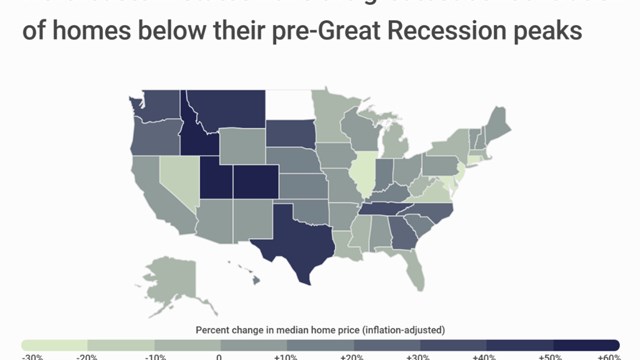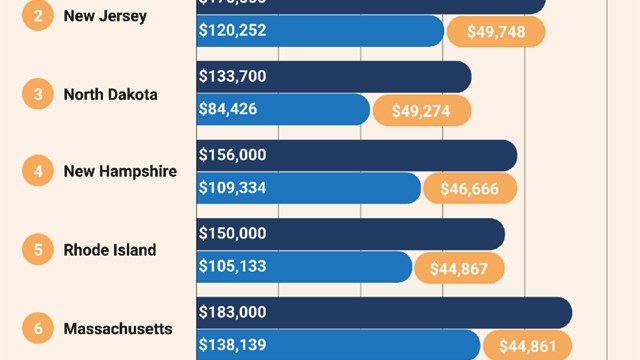
There's no question about it: economically speaking, it's been a very weird couple of years here in Gotham. While the outright market collapse so many feared seems to have been largely avoided, sellers who have seen double-digit declines in their apartments' value may be less than jubilant.
The Lay of the Land
It's a long-held truism that the city's residential housing market fluctuates in direct proportion to the strength or weakness of Wall Street’s indicators. While the New York City market was actually ahead of the economy in recent boom years, as the nationwide recession ground on into its third year, activity in the city’s housing market reflected the bleak climate in the Financial District. The sale of residential properties now is lagging behind the economy, which has shown some signs of life in recent months.
That being said, the local housing market did log a stronger month for sales in January of this year. Inventory declined sharply over the last year, from 12,000 properties offered for sale in 2009 to 8,700.
There are some interesting figures in relation to trends in the amount of co-op and condos on the market. Last year saw daily inventory levels well over 10,000 for most of the year, soaring close to 12,500 in the second quarter of 2009, then towards the end of the year a decline to the 8,000 range. As for total listings sold, in 2007 there were over 20,000 apartments sold, whilst in 2008, and 2009, both years saw a decline to around 12,000 closed sales.
"In general, transactions rose steadily from about 2003 to 2007, then they started to decline about the second quarter of 2008,” says Michael Slattery, senior vice president at the Real Estate Board of New York (REBNY). “Beginning in the second quarter of 2009, sales began increasing quarter to quarter though well below the high points of 2007-2008.”
According to information compiled by Yale Robbins, Inc., the average sales price of a co-op in New York City in the fourth quarter fell by three percent to $585,000 compared to the fourth quarter last year. The average sales price in Manhattan fell 13 percent year on year to $944,000. The average sales price in Brooklyn was down three percent to $327,000. The average sales price of a condominium in New York City in the fourth quarter of 2009 fell six percent to $1,087,000. Manhattan experienced a seven percent drop in the average sales price to $1,665,000. Brooklyn saw the biggest drop, with the average sales price of $502,000, a decrease of 15 percent year on year.
The numbers don't necessarily tell the whole story, however. Consumer attitudes and confidence in the housing market have improved, says Kirk Henckels, executive vice president and director of Stribling Private Brokerage. And that changed perspective has helped to increase sales.
Last year’s uncharacteristically slow market was really almost like two years in one, says Jacky Teplitzky, managing director for Prudential Douglas Elliman.
“Basically, 2009 was divided into January through September, with not much happening at that time,” she says. “People were nervous. From September through December however, all the people who didn’t buy realized that prices had gone down [and started to buy.]” Teplitzky calls the current market “stabilized,” with properties priced right and buyers looking for deals. “Last year nothing was happening,” she says.
“Last year was almost a standstill, and while it looks better now, we are still lagging behind. Everybody is being very cautious. People are negotiating to five percent below asking price.” While Teplitzky does concede that properties take longer to sell—four to six months on average—she says that's an improvement from the seven to eight months it took to sell similar properties in 2009.
The stabilization of the Dow Jones Average from August through September of last year did a good job bolstering consumer confidence, says Kathy Braddock, co-founder of Manhattan-based Charles Rutenberg Realty. Lower asking prices—sometimes a full third less costly than just a year ago—are also proving attractive to buyers.
Some of the uncertainty about pricing last year has been replaced with a confidence that the pros say is based in solid statistics on how much properties are being sold for, clearing up some vagueness in the market regarding prices. “Our market in New York is very Wall Street-driven,” says Braddock, “and with the Dow hovering around 10,000, we’re in much better shape.”
A Slow Rise
Even so, the market has a long way to go before it gets near its 2007-08 height. According to market experts, the impact of the current recession on New York City housing is worse than the housing slump associated with the 1990s recession, and may also be far worse than the 1980s recession. The current slowdown is a result of the overheated market in 2007, which really started to tank in the summer of 2008, says Neil Binder, co-founder of Bellmarc Realty in Manhattan. “In 2009, we suffered,” he says.
The decline hit the higher-end properties harder than others, in part because the implosion of the mortgage and banking industries conferred a social stigma onto buying higher-end properties, according to Henckels. “Luxury [housing] got a tainted name,” he says.
But even that segment of the housing market is picking up. While it is still a buyer’s market, the change in activity from a year ago is significant, Braddock says. “A year ago we were still in a free-fall,” she says, adding that the stabilization of the stock market and improvement in other key economic indicators have instilled some confidence in consumers. “It’s important for the Dow to be strong so people can pass the co-op board.”
In January alone there were 20 sales of co-ops valued at $5 million or more, versus a total of 80 such properties sold in all of 2009, Henckels says. “It doesn’t compare to 2008, when [sales of such properties] were double that,” he continues, “but we are experiencing a slow recovery.”
The recession caused property values in the market to drop by 25 percent in many cases, Henckels says, while noting that the stabilization of the market was bound to happen.
According to Binder, declines in prices may have bottomed out for some properties, but perhaps not for all. An overall 35 percent fall in values of upper-end housing in New York could slide even further—maybe even another 10 percent. Nonetheless, that potential drop hasn’t tamped down hopeful projections of continued growth in market activity through the next three quarters.
Running the Numbers
Prudential Douglas Elliman’s Fourth Quarter 2009 Manhattan Market Overview shows growing sales activity in the Manhattan market. The fourth quarter of 2009 was a continuation of the third quarter’s increased sales activity, with declining inventory, easing of price declines and price stabilization.
“Improvement in the national economy, rising stock market and mortgage rates at historic lows have all played a role in the improvement of the Manhattan housing market in the second half of 2009,” says Jonathan Miller, president/CEO of Miller Samuel, which prepared Prudential Douglas Elliman’s report.
During the fourth quarter of 2009, the market experienced a 10.9 percent increase in sales from the prior quarter. The activity bodes well, given that the housing market was very active for a time of year when sales generally decline as a result of the holiday season, says Dottie Herman, president and CEO of Prudential Douglas Elliman. “We believe that improved economic conditions and a strong belief in New York City all played a role in improving our housing market,” she says.
Industry experts agree that things are improving, but how it is unclear how quickly, and when exactly the market will be “normal” again, with a more even balance of power between buyer and seller. All in all, industry professionals are cautiously optimistic about the upcoming year.
“The bottom line is...the economy is showing positive signs,” Binder says. “Things should continue to pick up in spring and summer, with good momentum by fall.”
Finding Values
One upside to the crisis has been that the decrease in housing prices has made the city more affordable for some people, which has in turn helped to spur sales. This factor alone may account for the majority of recent sales, which during the past year have been most robust at the lower end of the price spectrum, and which experts expect to continue.
According to Binder, another change in the market has been the approach some buyers are taking when considering making a purchase. These days, many prospective buyers are hedging their bets by making offers on several properties at a time. The tactic is more common now than in the past, and some brokers are even recommending the technique, which they say can help a buyer to unearth a true bargain. “The best way to find a deal is to throw out a lot of offers and see what sticks,” Binder says.
It can sometimes be difficult to tell who the desperate sellers are because they are good poker players, Braddock says. “You only know you’ve got a motivated seller when they accept an offer.”
While sellers are playing it close to the vest, buyers are enjoying one of the best periods to buy New York City real estate in recent decades. Competitively priced properties that offer excellent values to buyers are more numerous now than in many years. The buyer’s market could continue for a while before the market stabilizes further, according to Binder and others.
Neighborhoods in which properties are expected to maintain or increase their values include the Upper East Side and Upper West Side. Financial District property values are suffering the most, and could be a risky investment in the estimation of some buyers. Still, industrious prospective buyers can find exceptional values if they're willing to play the aforementioned poker game.
“You have to seek out the really motivated sellers,” Henckels says. “It could be an estate selling a property, for example. Brokers tend to know these things more than the Internet. Very personal situations lead to good deals.”
The Upper East Side tends to have good values because it is the largest segment of the city. The value one might gain from buying a property depends upon the type of building one is seeking to live in, of course.
Braddock cautions that buyers should not have a “flip” mentality when considering buying a new home, especially in this market. “You better be happy with the home you buy, and you had better be sure you can afford it,” she says.
Very few extra amenities or “pot sweeteners” are being offered to entice buyers, Binder says, noting that the crucial factor is quite simply the price of the property.
According to Henckels, some minor concessions are being made in terms of small bonuses offered to the would-be buyer. “Sometimes the developer will offer to pay the transfer taxes on the property or for certain upgrades to the property, such as a new refrigerator,” he says, adding that on the whole, prices are less negotiable for newly developed properties.
Despite the decrease in inventory in the market, things won’t be getting tight anytime soon, Braddock says. “I think we are where we are for the next three to five years,” she says. “Pricing went up way too fast here. I’m not unhappy about a stable market that keeps a good, steady pace. I hope that the market will continue to stay steady.”
For 2010, “We’ll continue to stabilize pricing,” says Teplitzky, “I don’t think we’ll have a brisk year in real estate… but people who couldn’t sell their properties in 2009 will come to the market, and we’ll have a little more inventory than in 2008.”
And how will real estate industry professionals look back on 2009?
“Happily,” Henckels says, laughing at the thought of being past the worst economic slump in years. “Happy it’s over.”
Jonathan Barnes is a freelance writer and a frequent contributor toThe Cooperator and other publications.






Leave a Comment